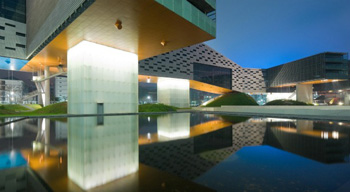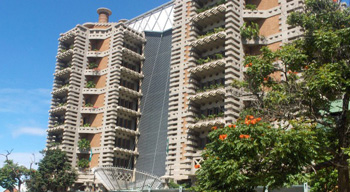By Logan Broyles
It seems green building is all the rage these days. Everywhere you look there are new projects popping up, new sustainable technologies being designed, and new standards being created that are constantly setting the bar higher.
With this in mind, we decided to examine one simple question.
What is the future of green building?
“Put it another way, is there a future in not building green?” asks Matt Fulford, the head of the Low Carbon Building at Sustain Co. based out of the UK.
“In the UK, from 2019 all new buildings will have to meet zero carbon standards; in France this is occurring in 2020,” Fulford says. “I believe that over the next 10 years we are going to see a fundamental change in the way buildings are designed, constructed and operated where green buildings will be the required norm. Within the next decade the future IS green building.”
Innovation and technology will lead the way as society shifts toward a more environmentally sustainable infrastructure. Here are some of the more interesting and out-of-the-box projects being worked on around the world that may one day hold the key to our future:
Horizontal Skyscrapers: Integrating with the Environment
After three decades of unprecedented industrialization and economic growth, China has become one of the world’s most prolific generators of pollution. To help curb this trend, the Chinese government has made several large scale commitments to improving its green footprint. Major corporations in China have followed suit, including China Vanke, the country’s largest residential developer.
Wang Shi, Vanke’s founder, is a noted environmentalist that has reached the peak of Mt. Everest twice. So it should come as no surprise that when the company announced plans to build a new headquarters in Shenzhen, it sought to create one of the most sustainable structures in China. The state-of-the-art Vanke Center is the first LEED Platinum-certified building in China.
Located in the Mirs Bay watershed in Shenzhen, China, the Vanke Center takes conventional skyscraper design and turns it on its ear. The 1.14 million square foot horizontal skyscraper hovers 50 feet above the ground. At 1,310 feet it is slightly longer than the Empire State Building is tall (1,250 ft.)
By elevating the sideways skyscraper on eight supporting structures, the buildings architect’s were able to turn the entire site (including the area under the building) into a park. Workers inside are treated to panoramic views of the South China Sea and the surrounding mountain ranges to the North.
Created by Steven Holl Architecture, this building marvel blends architecture and landscaping in one of the most sustainable buildings in China.
“In other parts of the world, clients want to nickel-and-dime sustainability, questioning every expenditure,” states Holl. “Chinese clients aren’t thinking that way. They’re thinking of building the future.”
The entire roof of the Vanke Center is covered in plants, the idea being that the same amount of green space would still exist on the site as if the building wasn’t there.
“The idea was to create a seamless integration of the buildings architecture with the surrounding landscape,” says Holl.
The horizontal skyscraper was built on reclaimed land that forms part of Shenzhen’s storm water management system. The complex serves as a retention pond and bio-swale connected to adjacent creeks. A redesigned waterfront retaining wall was built as a planted estuary, which minimizes erosion and run-off that can be harmful to the surrounding environment.
Storm water is redistributed throughout the site through a series of ponds, courtyards, planted mounds and sunken gardens. Rather than use pavement, the buildings’ designers used open-joint stone, grass-crete, gravel, and compressed sand pavers that can naturally absorb and filter water.
“The landscape is really a machine for cleaning the water and tempering the climate,” says Holl.
GeoEngineering: Remote-controlled clouds
With temperatures estimated to reach a sweltering 120 degrees in the summer heat, Qatar’s leaders have legitimate concerns about hosting the 2022 World Cup.
Engineers at Qatar University have announced plans to develop solar-powered artificial clouds to shade the field at the Lusail Iconic Stadium, where the Cup’s opener and final match will be played, as well as the eleven other stadiums where World Cup matches will be held. The $500,000 remote-controlled clouds would cool the field’s temperature by about 10 degrees, not exactly the greatest return on an investment.
The artificial clouds would be made of lightweight carbon and held aloft using helium-filled chambers. Solar-powered engines would allow users to move the clouds through the sky via remote control. A prototype is expected to be ready for testing by the end of the year.
Bio-Mimicry: Using Nature’s Designs
Mother Nature was the world’s first architect, so it stands to reason that mankind can learn a lot from basic designs and techniques found in the natural world around us. Bio-mimicry is the imitation of nature in building layouts.
Weighing in at a hefty 80,000 pounds with an average length of about 40-50 feet, Humpback whales only leave a wake of bubbles five feet across due to their sleek design. The whale’s surprising ability to cut through water with almost no impact is due mainly to the shape of its flippers.
Normally when water flows over smooth flippers it breaks up into choppy vortices. Humpbacks have large bumps on the edges of their flippers called tubercules that maintain even channels of fast-moving water, giving the whale a tighter grip on the water.
Wind tunnel testing has shown that tubercules can reduce drag by 32 percent and improve lift by eight percent. A company based out of Toronto called WhalePower is currently putting these findings into action, applying the tubercule design to its wind turbines.
Another example of biomimicry practices being applied in the construction industry is the Eastgate Building in Harare, Zimbabwe. The building copies Macrotermes michaelseni, a type of termite that builds self-cooling termite mounds that maintain the temperature in their nests within one degree, regardless of what the weather is like outside.
The Eastgate Building uses 90 percent less energy for its ventilation than typical buildings of the same size, and has already saved its owners $3.5 million in air conditioning costs.
COPYRIGHT 2011 CONSTRUCTION DIGITAL MAGAZINE
REPRINTED WITH PERMISSION FROM CONSTRUCTION DIGITAL MAGAZINE


